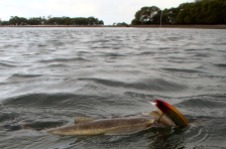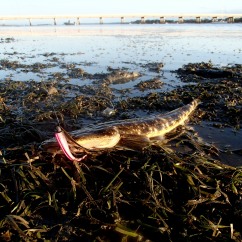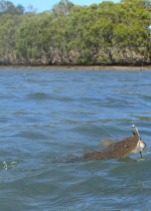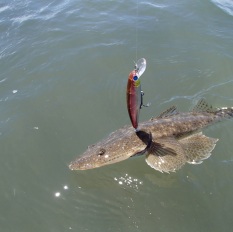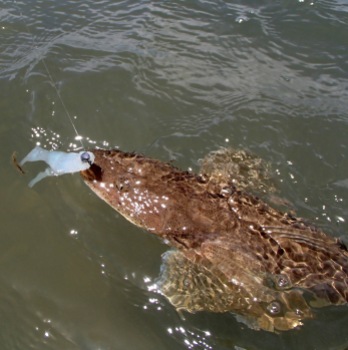Saturday
Back to early morning low tides for the weekend. On Saturday it would be at about 7.00 am. There was a bit of rain around. The northerly winds had been coming and going. The temperatures were warm again but the water is continuing to gradually cool down.
I arrived at the Bribie Bridge a little after 5.00 am. First light would be at about 5.30 am and there was no breeze. I had selected a variety of soft plastics lures to run through. I started with a 3“ Zman Minnowz in the Opening Night colour, on a 1/8th ounce, size 1/0 hook Headlockz Jighead. I chose 12lb fluorocarbon leader and started fishing from the shadows cast by the bridge lights.
At 5.18 am I caught the first fish of the day – a 43cm flathead. It was sitting just to the south of the patch of reef near pylon number five. The tide was running pretty quickly. This can work against the Zmen as they are definitely more buoyant than most other soft plastic lures. After five minutes, I caught another, bigger flathead about 10 metres further south.
There were prawns jumping everywhere and a bit of surface feeding going on, so I swapped to a slightly thinner profile 3.75“ Zman Streakz, in the Redbone (glow) colour. I cast around and got plenty of hits from something a bit more agile than a flathead. I assumed it was the small Moses perch that are often around, or perhaps some bream. Either way, eventually it was a flathead that I caught with it – about 10 minutes later.
The sun was now up and I moved south, past the old oyster jetty. I swapped to a different colour in the 3.75” Zman Streakz – Shine. I thought I might find a few more bream and I think I had a few bream bites before I caught yet another flathead at 5.47am. I swapped to a 4 inch Zman Streakz Curltailz in the Bloodworm colour and after a few casts, this caught another flathead. This was a very good size fish – somewhere between 65cm and 70 cm. I worked through the Zmans, catching a couple more fish on the 3“ Minnowz in the Redbone colour.
It was now about 6.30 am and the sky was looking ominous. A soaking looked like a certainty but at least there was still no real wind blowing. I swapped to my last remaining Rio Prawn lure – the biggest one in their range – the 19 gram. I thought the colour I had was the original or ‘Natural’ but I see it’s actually called ‘Night Glow’. This soon did the trick and I pulled in three or four more flathead over the next 30 minutes. The bigger lure seemed to attract some slightly bigger fish, but after a few tussles the worn leader snapped and I lost my lure to a particularly aggressive, headshaking flathead.
Size of lure did not seem to be an issue so I pulled out the DUO Jerkbait 120 SP. This is a suspending, flat sided, hard bodied minnow that seems to drive the tailor nuts. At 120 mm long it is bit larger than the usual flathead favorites but I thought I would give it a try. I did not have to wait long. The first taker was a fairly small flathead – just over 40cm. The next, a few casts later was a very decent fish – nudging 60 cm. The Duo Jerkbait kept catching fish through the bottom of the tide.
As the tide started its run in I decided to switch to a small lure and see if the fish were still interested. I pulled out the DUO Tetra Works Pocopoco sinking popper. This is a light (4.7 gram) popper that can still be worked quickly on the surface. I had it in the Pink Clown colour. It did not take long to find the fish. Unfortunately it did not last long. I had not upgraded the factory treble hooks. These are too soft for wrestling with hard mouthed flathead and so after a few captures one had broken off and the other was all bent out of shape. On to the next lure – the DUO Ebikko hard bodied, sinking shrimp imitation. This time I had it in a pearly white colour. Once more, I did not have to wait long and after three or four casts I found a fish – another 45cm+ flathead.
It was now about 8.00 am. The stormy skies seemed to have fired the fish up even more than usual. I carried on working my way through the tackle bag. Next I offered a Sebile ¼ ounce Spin Shad – I have never caught much with this lure although I think it should catch plenty of fish. It did not have much trouble today and after a couple of hits the treble hook bit and pulled in another flathead. The last hard body in the bag was a tiny orange and purple Japanese-made bug. This performed like all the others and soon caught a fish.
I finished up the session catching a few more flathead on the Powerbait Rippleshad – first the 5” in the Cola colour and then the 3” in the Perch colour. The fish were very aggressive which might have been because of the barometric pressure drop caused by the big storm that was approaching. At 9.00 am I was back at the car after another great session.






